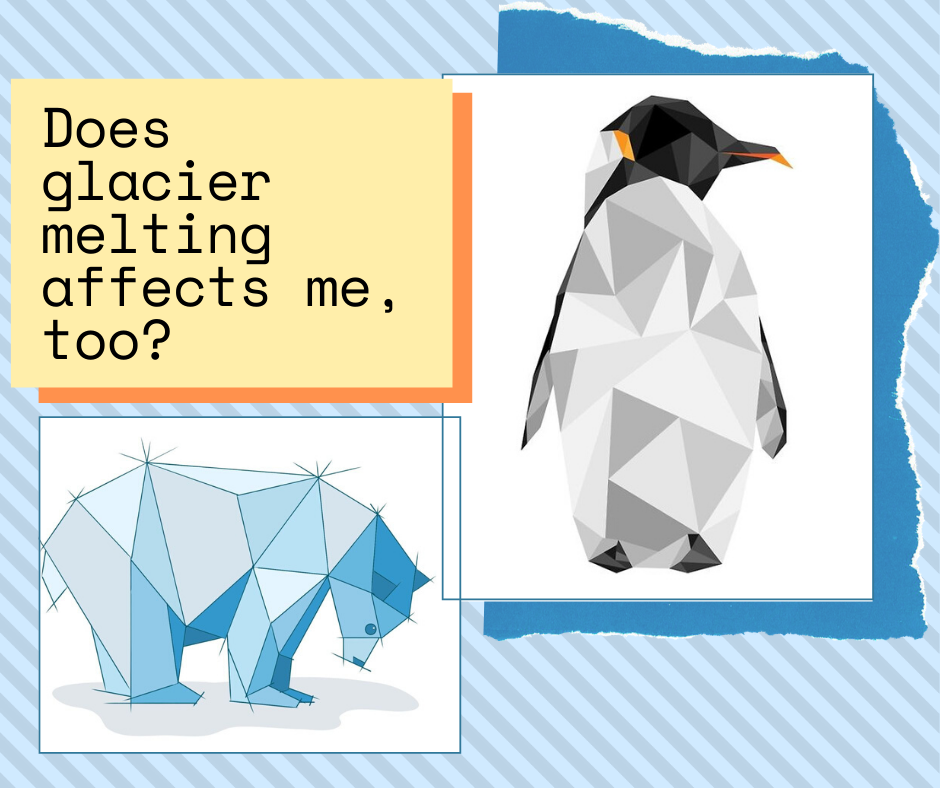
What happens in the Arctic, DOES NOT stay in the Arctic
First of all, what is happening in the Arctic?
I'm guessing that the melting of glaciers due to climate change is no longer flash news to you, right?
However, have you ever wondered how, the disappearance of big chunks of ice hundreds of miles away from you is going to affect you, personally?
You might think of the great ice sheets in Greenland and Antarctica as giant banks of freezers. And we ran down those freezers, unplugging them. Once we unplug our freezer, it's unplugged. That's it. No going back. And it's going to melt.
Due to unchecked human activities around the globe, global warming has a free reign on the planet for a long time now. The effects of global warming are never instant. However, when they do decide to strike, we are witnessing waves of destruction and deaths.
One of the regions most affected by climate change was the Arctic and Antarctic. Recent studies revealed glaciers are melting 100 times quicker than previously thought.
Still, you might still be confused about how all this is impacting you. Well, there it is:
SHORTAGE OF FRESHWATER

97% of the water on earth is seawater.
Only 3% of that is freshwater. That 3 % is supposed to be enough for all the people on this planet. That would be 7.7 billion people.
About 75% of the freshwater is trapped in glaciers and snow. Now, with the accelerated melting rate, a lot more freshwater is lost into oceans where they mix with saline water, making it non-consumable.
This, combined with the increase in population will lead to a serious scarcity of freshwater in the upcoming years.
EXTREME FLOODING

The accelerated melting of the glaciers is causing an abrupt rise in water input to other water bodies such as the rivers, lakes, and seas. Currently, we don't have any kind of plan for harvesting water in those places. Therefore all the coastal cities will end up underwater, forcing people to migrate to other areas.
There already are coastal areas around the world that are recording higher sea level and rising tides as the volume of water is constantly increasing.
According to the UN, more than 600 million people live in coastal areas that are less than 10 meters above sea level.
A RETURN OF LETHAL DISEASES

For years, glaciers have been absorbing harmful chemicals, ancient viruses, and bacteria, as well as banned pesticides that went airborne. Ice is a purifier and makes all that nasty stuff become inactive in those cold conditions.
As the ice continues to melt, some of these trapped bacteria, viruses, and chemicals are at risk of being released back into circulation. If this would happen, humankind might face diseases that would lead to extinction.
ELECTRICITY SHORTAGE

Hydro-electric power depends on rivers which get their water from highlands. These highlands and mountains have ice which melts during the warm months to produce streams which join up to form rivers which power hydro-electric turbines.
As ice disappears, rivers will eventually dry up, putting an end to hydro-electric power, which a considerable percentage of the population depends on.
Now, we all know that the modern world cannot do without electricity, therefore, people will do other forms of producing electricity, some of which will end up polluting the environment and further increasing global warming.
DISRUPTION OF WEATHER PATTERNS

Weather is mainly controlled by sea currents that cross the oceans. Changes in the amount of sea ice can disrupt normal ocean circulation, thereby leading to changes in the global climate. Even a small increase in temperature can lead to greater warming over time, making the polar regions the most sensitive areas to climate change on Earth.
Changing the currents movement leads to storms and hurricanes in places that never used to experience them. If things with climate change continue to go down this path, deserts will start to receive snowfalls while tropical areas will start drying up due to lack of rain.
This will cause disruption of the current balance of life, causing plants and animals to go extinct.
This will be the end of life as we know it.
EXTINCTION OF ANIMALS

Due to the disappearance of polar ice in the North and South Pole, polar bears numbers have dramatically decreased. Polar bears are now listed as a threatened species under the United States' Endangered Species Act as polar bear populations declined.
As the climate gets warmer, they are exposed to an unfamiliar environment, this also impacting their source of food, forcing them to go into the cities to search for food rather than starve to death.
Polar bears are not the only species at risk. As the arctic is running out of ice, walruses are now forced to climb on rocky islands. Often there is not enough space for everyone, so the poor animals climb up the rocks not knowing how to climb down, leading to their deaths.
AN INCREASE IN EARTHQUAKES AND VOLCANIC ERUPTIONS

When they are intact, glaciers exert enormous pressure on the portion of the Earth's surface they cover. When glaciers begin to melt—as they are doing now at an increasingly rapid rate due to global warming—that pressure is reduced and eventually released.
Geologists say releasing that pressure on the Earth's surface will cause all sorts of geologic reactions, such as earthquakes, tsunamis (caused by undersea earthquakes), and volcanic eruptions.
New Seismic Events Already Happening
Melting ice in Antarctica is already triggering earthquakes and underwater landslides. These events aren't getting much attention, but they are early warnings of the more serious events that scientists believe are coming.
Tsunamis and volcanic eruptions will also increase with time causing destruction and death in places that never had any history of earthquakes.
DISAPPEARANCE OF CORAL REEFS

Coral reefs provide shelter for over a quarter of all the animal species living in the sea, they also protect shorelines and provide regulation of oxygen and carbon dioxide. With sea waters rising, the sun no longer reaches the coral reefs causing them to dye out across the planet. With them, the fish population and seafood also disappears.
This is affecting numerous people who depend on the sea to survive, causing a food shortage crisis.
THE RELEASE OF METHANE GAS

Under the glacier is trapped a lot of methane gas. It is not a toxic gas, however, it contributes to further increase the global temperature as it is cataloged as a greenhouse gas.
It is estimated that more than 50 gigatonnes of methane in the Arctic could be released within a few years into the atmosphere at the current pace of global warming.
Pretty scary, huh?
If there is one thing I have learned while researching for this blog is that it is within our power to make a change. No matter how small we might find it. It counts. It's time to live a more sustainable waste-free life. Time to think twice when we buy something and three times when we dispose of it.
Remember, what happens in the Arctic, DOES NOT stay in the Arctic!

